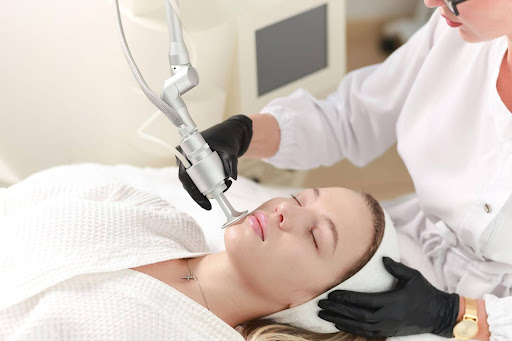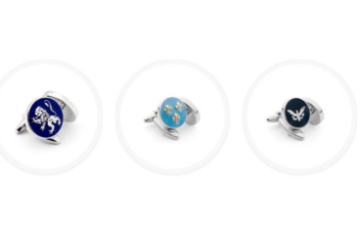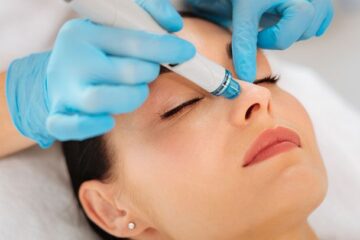Choosing between a chemical peel and laser resurfacing depends on your skin goals, tolerance for downtime, and desired results. Chemical peels use acids to exfoliate layers of skin, improving texture and tone with minimal downtime for lighter versions. Laser resurfacing uses focused light to remove or remodel skin tissue, offering dramatic wrinkle reduction and collagen stimulation – but often requires longer healing. Both are effective facial resurfacing options; the best choice hinges on your skin condition and lifestyle.
Table of Contents
- Chemical Peel vs Laser: The Ultimate Breakdown
- What to Consider Before Booking Your Session
- Final Thoughts: Matching Treatment to Your Skin Journey
Few things affect confidence like the way your skin looks and feels. Whether it’s lingering acne scars, sun spots from summers past, or fine lines that seem to appear overnight, these concerns can be stubborn–even with a diligent skincare routine. That’s where professional skin resurfacing treatments come in. Among the most trusted options today are chemical peel and laser resurfacing, two approaches that renew the skin in fundamentally different ways.
If you’re exploring what a chemical peel involves–from how it works to what recovery looks like – detailed overviews, such as https://www.theinjectionist.ca/calgary/chemical-peels-calgary, can offer helpful context before you consult a provider.
Chemical Peel vs Laser: The Ultimate Breakdown
When weighing chemical peel vs laser, it’s essential to understand not just the outcomes, but the mechanisms, ideal candidates, and realistic expectations for each. Both are powerful facial resurfacing tools – but they operate on different principles and timelines. Below, we unpack how each works, who benefits most, and what you can expect in terms of results, recovery, and investment.
How Chemical Peels Work & Who They’re For
A chemical peel involves applying a controlled acid solution – often glycolic, salicylic, or trichloroacetic acid – to the skin’s surface. This solution dissolves the bonds between dead and damaged skin cells, prompting them to slough off over the following days. As new skin emerges, it’s typically smoother, brighter, and more evenly toned.
Best suited for:
- Those targeting mild to moderate sun damage, acne scars, or uneven pigmentation
- Individuals seeking minimal downtime (especially with superficial peels)
- People with sensitive skin who may not tolerate heat-based treatments
- Anyone wanting gradual, cumulative improvement over multiple sessions
Recovery varies by depth: light peels require 1–3 days of flaking; medium peels may need 5–7 days of redness and peeling; deep peels (rare and medically supervised) can take weeks to heal. Results from lighter peels last 1–2 months, while deeper treatments can offer benefits for years.
Laser Resurfacing Explained: Types & Outcomes
Laser resurfacing uses focused light energy to either remove layers of skin (ablative lasers like CO2 or Erbium) or heat the deeper dermis to stimulate collagen without surface damage (non-ablative lasers like Fraxel). Ablative lasers deliver more dramatic results but require 7–14 days of downtime. Non-ablative options involve little to no downtime but require multiple sessions for visible change.
Best suited for:
- Deep wrinkles, pronounced sun damage, or significant scarring
- Patients willing to accept longer recovery for more transformative outcomes
- Those with resilient skin types that heal well under thermal stress
- Individuals seeking long-term structural improvement, not just surface renewal
Unlike peels, lasers offer precise control over depth and intensity. Ablative treatments often deliver results that last 5+ years with proper skincare, while non-ablative results build gradually and may need touch-ups every 6–12 months.
Side-by-Side Comparison: Results, Downtime, Cost

To simplify your decision, here’s a quick-reference table:
| Factor | Chemical Peel | Laser Resurfacing |
| Best For | Texture, tone, mild scarring | Deep wrinkles, severe sun damage |
| Downtime | 1–7 days (up to 2 weeks for deep) | 3–14 days (ablative) / None (non-ablative) |
| Sessions Needed | 3–6 for cumulative results | 1–3 (ablative) / 4–6 (non-ablative) |
| Pain Level | Mild to moderate stinging | Moderate to high (numbing used) |
| Cost (Average) | $150–$600 per session | $500–$2,500+ per session |
| Longevity of Results | 1 mo – 5+ yrs (depth-dependent) | 1–2 yrs (non-ablative) / 5+ yrs (ablative) |
Realistic Expectations: What Each Treatment Fixes Best
Chemical peels excel at:
- Brightening dull complexions
- Smoothing rough texture and enlarged pores
- Fading superficial hyperpigmentation and melasma
- Reducing acne breakouts and shallow scarring
Laser resurfacing shines when addressing:
- Deep-set wrinkles around eyes and mouth
- Surgical or traumatic scars
- Significant photodamage with leathery texture
- Loss of firmness due to collagen depletion
Neither treatment is a magic eraser – both require patience, proper aftercare, and often, maintenance. Sun protection is non-negotiable post-treatment, regardless of the method chosen.
What to Consider Before Booking Your Session
Choosing between chemical peel and laser resurfacing isn’t just about the procedure – it’s about your lifestyle, skin history, and readiness for aftercare. Rushing into either treatment without proper preparation can compromise results or prolong recovery. Here’s what every patient should evaluate before scheduling.
Skin Type & Sensitivity
Not all skin responds the same way. Those with darker complexions may face higher risks of hyperpigmentation with aggressive peels or ablative lasers. Sensitive or reactive skin often tolerates lighter chemical peels better than thermal treatments. A consultation with a licensed provider is non-negotiable – they’ll assess your Fitzpatrick skin type and medical history to recommend the safest approach.
Downtime Tolerance
Be honest with yourself: can you afford 10 days of social downtime? Ablative laser resurfacing often requires 7–14 days of redness, crusting, and sensitivity. Medium-depth chemical peels may need 5–7 days of visible peeling. If you’re juggling work, school, or events, a series of non-ablative laser sessions or superficial peels may be a more realistic option – even if the results build gradually.
Pre-Treatment Prep Is Mandatory
Skip the self-tanner and beach vacation. Sun exposure before treatment increases complications like pigmentation irregularities. Avoid retinoids, strong exfoliants, or waxing for 5–7 days prior. Some providers may recommend pre-conditioning your skin with gentle acids or growth serums – but never self-prescribe. Follow professional guidance to the letter.
Post-Care Commitment
Your results depend on what you do after treatment. Expect to:
- Apply healing ointments or barrier creams as directed
- Avoid makeup for 3–7 days (longer for deeper treatments)
- Wear SPF 50+ daily – even indoors or on cloudy days
- Resist picking, scrubbing, or exfoliating until fully healed
Failure to protect new skin can undo weeks of progress – or worse, cause scarring.
Budget & Maintenance
Light chemical peels start around $150 per session but require 3–6 visits for full effect. Ablative lasers can cost over $ 2,000 but often deliver long-term transformation in a single session. Factor in follow-ups, skincare upgrades, and potential touch-ups. Neither treatment is “one and done” – maintenance is part of the investment.
Final Thoughts: Matching Treatment to Your Skin Journey
Choosing between chemical peel and laser resurfacing isn’t a verdict on which is superior – it’s a personal alignment of your skin’s needs, your lifestyle’s rhythm, and your long-term aesthetic goals. Both facial resurfacing treatments deliver proven, visible results, but they serve different chapters in your skin’s story.
Whether you lean toward the controlled exfoliation of a chemical peel or the collagen-triggering power of laser resurfacing, the best choice is the one that fits your life – not someone else’s results. Start where you are. Treat wisely. And let your skin evolve, naturally and confidently, with you.



